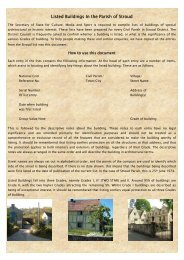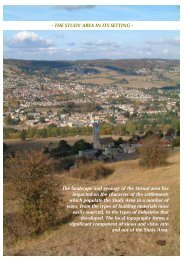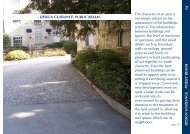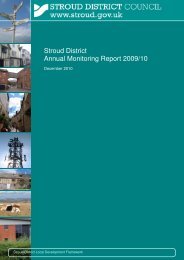CONSERVATION AREA STATEMENT - Stroud District Council
CONSERVATION AREA STATEMENT - Stroud District Council
CONSERVATION AREA STATEMENT - Stroud District Council
You also want an ePaper? Increase the reach of your titles
YUMPU automatically turns print PDFs into web optimized ePapers that Google loves.
<strong>CONSERVATION</strong> <strong>AREA</strong> <strong>STATEMENT</strong> - Conservation Area No7: FRAMPTON ON SEVERN<br />
Historically, though, the majority of the population worked in agriculture. The flood- prone land around Frampton on<br />
Severn was best suited to the grazing of animals and the cultivation of orchards; however, arable crops were grown,<br />
too.<br />
At the beginning of the 16th century the main village industry, apart from agriculture, was connected with cloth<br />
manufacture. The manufacture of cloth has been an integral part of the <strong>Stroud</strong> area’s history and Frampton played<br />
its part. There was already a mill in Fromebridge at time of the Domesday survey, probably originally used for grinding<br />
corn, but evidence suggests that it was in use as a fulling mill by the mid 14th century.<br />
Frampton seems to have lost its place in the cloth industry before the (largely) boom times of the late 18th and 19th<br />
centuries; by 1775 Fromebridge Mill had become one of the biggest wire-works in the country, producing wire for use<br />
in carding and fishhooks. Where once weavers and cloth finishers featured prominently, the 19th century saw a greater<br />
part of the population, (excluding those employed on the river and in agriculture), supported by trade and other types<br />
of manufacture. The village was almost self-sufficient. Goods that could not be grown or made were generally bought<br />
at the twice-weekly canal borne outings to the market in Gloucester.<br />
Among the various trades and industries that flourished around Frampton, were those that exploited the natural<br />
resources of the area. Clay was extracted, chiefly for use in brick and tile manufacture. A brickyard and limekiln were<br />
in use in 1782, and Frampton brick-makers were recorded in the mid 19th century, although it is likely that the industry<br />
had been practiced for generations. In spite of the fact that the high proportion of salt in the clay made the bricks<br />
rather unsatisfactory and prone to failure, many of the buildings in Frampton were constructed using this most local<br />
of materials.<br />
The gravel on which the village sits was already being dug by 1646 and its extraction steadily increased throughout<br />
the 18th and 19th centuries to the point that, in 1879, the gravel pits could be described as being ‘ fairly large’. They<br />
were greatly extended in the early 20th century when much of the gravel was taken by canal to Avonmouth and used<br />
in the building of the docks.<br />
Extraction continues in the area, although on a much reduced scale. The railway that once took the gravel for shipment<br />
to Sharpness has long been dismantled and the gravel pits have flooded; some are now in use for water sports.<br />
A major employer came to Frampton in 1916, with the establishment of the Cadbury’s factory by the canal. Ground<br />
cocoa beans and sugar were blended with locally produced milk and then baked to form ‘chocolate crumb.’ This was<br />
put into sacks and taken by boat along the Gloucester- Sharpness, and Birmingham and Worcester canals to the<br />
main Cadbury works at Bournville for final processing into milk chocolate.<br />
The continuing employment ensured that the Frampton on Severn did not stagnate. The Rural <strong>District</strong> <strong>Council</strong> built<br />
200 new houses to the north of the Green in the mid 20th century and the village has continued to expand since, even<br />
after the closure of the Cadbury’s factory in 1983. (Its site is now occupied by several businesses).<br />
<strong>Stroud</strong> <strong>District</strong> <strong>Council</strong><br />
9

















